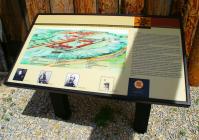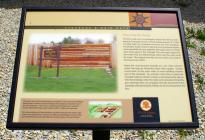Inscription
Fort Atkinson was founded in 1840 as a temporary post to keep the Winnebago (Ho-Chunk) Indians west of the Mississippi River on the land known as the Neutral Ground after their removal from Wisconsin. The Neutral Ground was intended for exclusive use by Indians and as a buffer zone between the Sioux to the north and the Sauk and Meskwaki Indians to the south. When the Winnebago were moved into the area, it was the duty of the Fort Atkinson troops to maintain peace among these tribes who were sometimes hostile to one another. Patrols were routinely sent out from the fort to prevent Euro-American traders and settlers from illegally entering this region. The post also reinforced the authority of the Indian Sub-agent, a U.S. government official who operated a school and model farm and provided supplies for the Winnebago at the Turkey River Sub-agency located about four miles downstream.
The design for Fort Atkinson was typical of most U.S. Army frontier post: a rectangular layout enclosed by a wooden picket-stockade, the parade ground was at its center, surrounded by four main barrack buildings. There were cannon houses in the northeast and southwest corners, a powder house to the southeast, and commissary to the northwest. Outside the picket-stockade were 14 additional buildings including the post's stables, granary, bakery, laundresses' huts, and blacksmith shops. Each was constructed of limestone or hewn logs with cut-pine shingle roofs. Three of the six years regular troops were garrisoned at Fort Atkinson were spent constructing the fort.
When the regular troops were called to the Mexican War in 1846, Iowa volunteer militia staffed the fort until the Winnebago were removed from Iowa in 1848. The last of the militia abandoned Fort Atkinson in early 1849.
In 1855, the fort was sold at public auction. The new owners had the property surveyed and platted as the town of Fort Atkinson. The State of Iowa acquired a portion of the military fort in 1921 and dedicated it as a State Preserve in 1968.
Most of the fort's buildings were constructed of stone quarried from the adjacent hillside. In 1906, while conducting geological studies of Winneshiek County, Professor Samuel Calvin named this stone the Fort Atkinson Limestone Member of the Maquoketa Formation and designated the quarry at the southwest corner of the old fort as the geological type section. The limestone seen here originated in a shallow tropical sea 440 million years ago.
Fort Atkinson State Preserve is managed by the Iowa Department of Natural Resources under the guidance of the State Preserves Advisory Board.
The design for Fort Atkinson was typical of most U.S. Army frontier post: a rectangular layout enclosed by a wooden picket-stockade, the parade ground was at its center, surrounded by four main barrack buildings. There were cannon houses in the northeast and southwest corners, a powder house to the southeast, and commissary to the northwest. Outside the picket-stockade were 14 additional buildings including the post's stables, granary, bakery, laundresses' huts, and blacksmith shops. Each was constructed of limestone or hewn logs with cut-pine shingle roofs. Three of the six years regular troops were garrisoned at Fort Atkinson were spent constructing the fort.
When the regular troops were called to the Mexican War in 1846, Iowa volunteer militia staffed the fort until the Winnebago were removed from Iowa in 1848. The last of the militia abandoned Fort Atkinson in early 1849.
In 1855, the fort was sold at public auction. The new owners had the property surveyed and platted as the town of Fort Atkinson. The State of Iowa acquired a portion of the military fort in 1921 and dedicated it as a State Preserve in 1968.
Most of the fort's buildings were constructed of stone quarried from the adjacent hillside. In 1906, while conducting geological studies of Winneshiek County, Professor Samuel Calvin named this stone the Fort Atkinson Limestone Member of the Maquoketa Formation and designated the quarry at the southwest corner of the old fort as the geological type section. The limestone seen here originated in a shallow tropical sea 440 million years ago.
Fort Atkinson State Preserve is managed by the Iowa Department of Natural Resources under the guidance of the State Preserves Advisory Board.
Details
| HM Number | HM1PBC |
|---|---|
| Tags | |
| Placed By | Erected by the State Historical Society of Iowa, Iowa Department of Natural Resources, and the Friends of Fort Atkinson, 2000 |
| Marker Condition | No reports yet |
| Date Added | Sunday, November 15th, 2015 at 9:02am PST -08:00 |
Pictures
Photo Credits: [1] DEBRA J. RICHARDSON [2] DEBRA J. RICHARDSON [3] DEBRA J. RICHARDSON [4] DEBRA J. RICHARDSON [5] DEBRA J. RICHARDSON
Locationbig map
| UTM (WGS84 Datum) | 15T E 586257 N 4777540 |
|---|---|
| Decimal Degrees | 43.14570000, -91.93923333 |
| Degrees and Decimal Minutes | N 43° 8.742', W 91° 56.354' |
| Degrees, Minutes and Seconds | 43° 8' 44.52" N, 91° 56' 21.24" W |
| Driving Directions | Google Maps |
| Area Code(s) | 563 |
| Closest Postal Address | At or near 301-303 2nd St, Fort Atkinson IA 52144, US |
| Alternative Maps | Google Maps, MapQuest, Bing Maps, Yahoo Maps, MSR Maps, OpenCycleMap, MyTopo Maps, OpenStreetMap |
Is this marker missing? Are the coordinates wrong? Do you have additional information that you would like to share with us? If so, check in.
Nearby Markersshow on map
Show me all markers in: Fort Atkinson, IA | Winneshiek County | 52144 | Iowa | United States of America
World War I Mine, a War Memorial
Dr. Norman E. Borlaug - March 25, 1914 - September 12, 2009
Howard County Historical Society-1854 Log Cabin-Beadle Park
Space Tree
101-A Train - EMD Model FP7
Allamakee County Court House Museum
Norwegian House
Spring Grove Area Veterans Memorial
The Portland Prairie Methodist Episcopal Church
Preston Overlook
Maintenance Issues
- Is this marker part of a series?
- What historical period does the marker represent?
- What historical place does the marker represent?
- What type of marker is it?
- What class is the marker?
- What style is the marker?
- Does the marker have a number?
- What year was the marker erected?
- Can this marker be seen from the road?
- Is the marker in the median?





Comments 0 comments